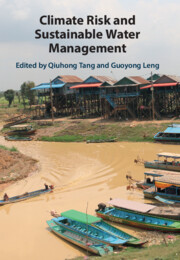Book contents
- Climate Risk and Sustainable Water Management
- Climate Risk and Sustainable Water Management
- Copyright page
- Contents
- Contributors
- Preface
- Acknowledgements
- Part I Water-Related Risks under Climate Change
- Part II Climate Risk to Human and Natural Systems
- 7 Observed Urban Effects on Temperature and Precipitation in Southeast China
- 8 Vegetation Dynamics, Land Use and Ecological Risk in Response to NDVI and Climate Change in Nepal
- 9 Climate Warming Induced Frozen Soil Changes and the Corresponding Environmental Effect on the Tibetan Plateau
- 10 A Review of the Effects of Climate Extremes on Agriculture Production
- 11 Agricultural Water Use Estimation and Impact Assessment on the Water System in China
- 12 Impact of Inter-Basin Water Transfer on Water Scarcity in Water-Receiving Area under Global Warming
- 13 Broadening and Deepening the Rainfall-Induced Landslide Detection
- 14 Estimating Aquifer Depth in Arid and Semi-arid Watersheds using Statistical Modelling of Spectral MODIS Products
- Part III Sustainable Water Management under Future Uncertainty
- Index
- References
12 - Impact of Inter-Basin Water Transfer on Water Scarcity in Water-Receiving Area under Global Warming
A Case Study of the South-to-North Water Diversion Project
from Part II - Climate Risk to Human and Natural Systems
Published online by Cambridge University Press: 17 March 2022
- Climate Risk and Sustainable Water Management
- Climate Risk and Sustainable Water Management
- Copyright page
- Contents
- Contributors
- Preface
- Acknowledgements
- Part I Water-Related Risks under Climate Change
- Part II Climate Risk to Human and Natural Systems
- 7 Observed Urban Effects on Temperature and Precipitation in Southeast China
- 8 Vegetation Dynamics, Land Use and Ecological Risk in Response to NDVI and Climate Change in Nepal
- 9 Climate Warming Induced Frozen Soil Changes and the Corresponding Environmental Effect on the Tibetan Plateau
- 10 A Review of the Effects of Climate Extremes on Agriculture Production
- 11 Agricultural Water Use Estimation and Impact Assessment on the Water System in China
- 12 Impact of Inter-Basin Water Transfer on Water Scarcity in Water-Receiving Area under Global Warming
- 13 Broadening and Deepening the Rainfall-Induced Landslide Detection
- 14 Estimating Aquifer Depth in Arid and Semi-arid Watersheds using Statistical Modelling of Spectral MODIS Products
- Part III Sustainable Water Management under Future Uncertainty
- Index
- References
Summary
Water scarcity is increasingly perceived as a risk in semi-arid and arid regions and it will be more critical in the future. Inter-basin water transfer (IBT) is widely considered as a climate adaptation strategy to minimize water scarcity in water-receiving areas. The South-to-North Water Diversion (SNWD) project is the world’s largest IBT project to alleviate severe water shortages in the Huang–Huai–Hai (HHH) region in China. This chapter takes the SNWD project as an example to quantitatively investigate the impact of the large scale IBT on water scarcity in the HHH region within the context of climate change. The results show that during the twenty-first century, the water supply risk in the region is projected to increase as a result of climatic and societal change. The SNWD project can greatly alleviate water scarcity but might be insufficient in some cases. Besides, to keep pace with escalating demands and completely alleviate water supply problems, demand-oriented management schemes, such as improvement in irrigation water use efficiency, must be undertaken.
Keywords
- Type
- Chapter
- Information
- Climate Risk and Sustainable Water Management , pp. 240 - 266Publisher: Cambridge University PressPrint publication year: 2022

